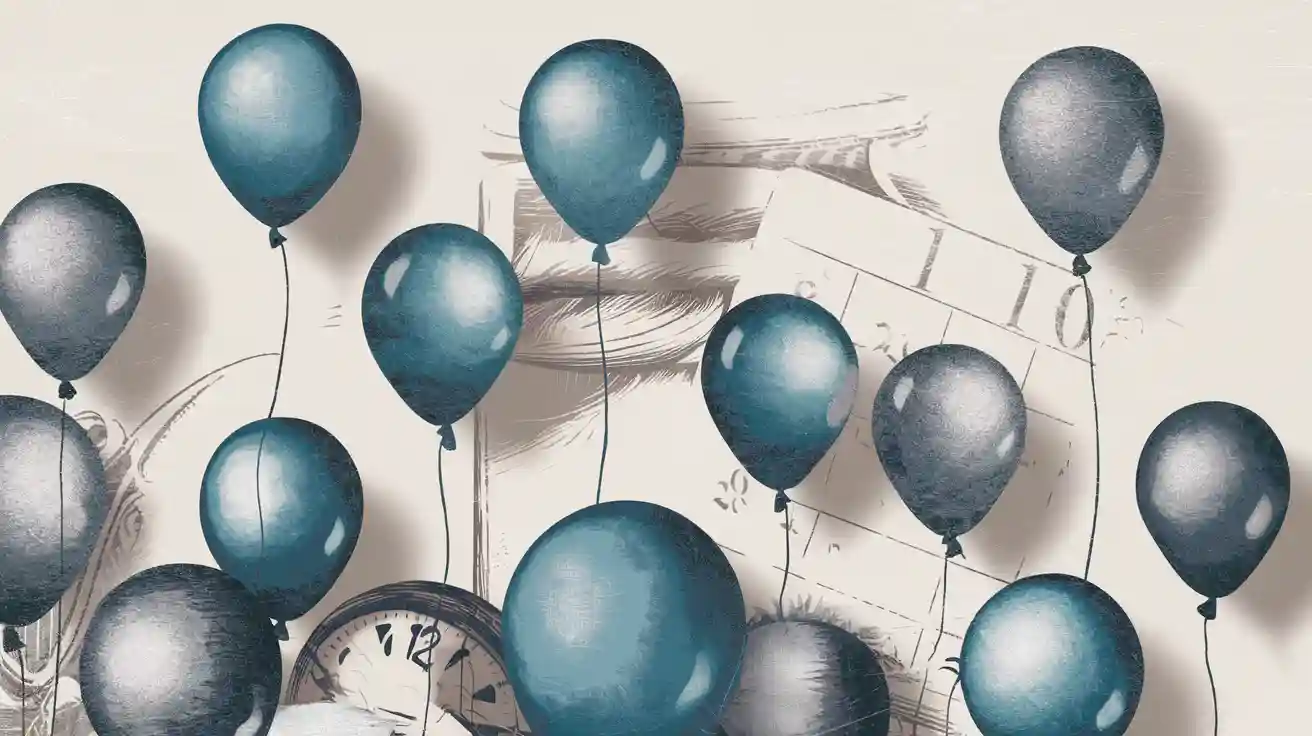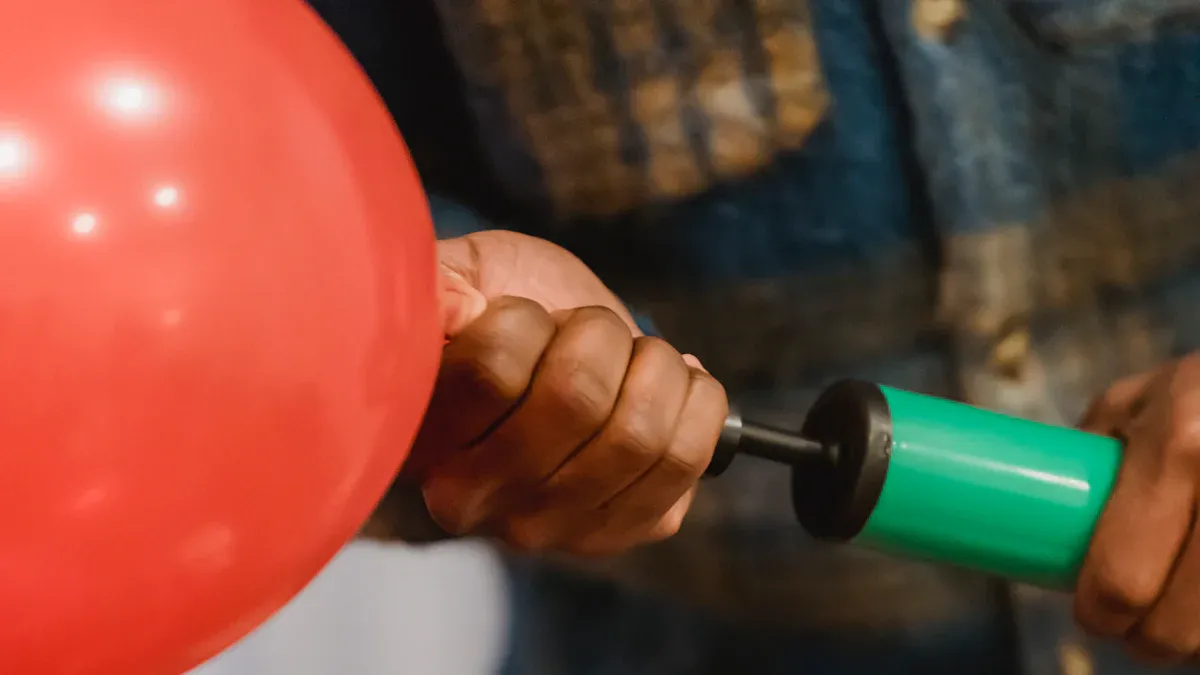
Helium latex balloons typically float for 8 to 12 hours, but their lifespan depends on several factors. For example, 10-inch balloons last 8 to 10 hours, while 12-inch ones can float for up to 12 hours. Treating helium-filled balloons with Hi-Float significantly extends their float time, with some lasting weeks instead of hours.
Key Takeaways
Helium latex balloons usually float for 8 to 12 hours. Bigger balloons float longer because they hold more helium.
Adding Hi-Float can make latex balloons float for days, not hours.
Inflate balloons 1–2 hours before your event for best looks. Keep them in a cool, dry spot to make them last longer.
Factors That Affect the Float Time of Helium Latex Balloons
Balloon Size and Material
The size and material of your balloon play a crucial role in determining its float time. Larger helium latex balloons tend to float longer because they can hold more helium. For example, a 10-inch balloon floats for 8 to 10 hours, while a 12-inch balloon can last up to 12 hours. The table below summarises the relationship between balloon size and float time:
Balloon Size | Float Time (Hours) |
|---|---|
9 Inch | 8-9 |
10 Inch | 8-10 |
12 Inch | 12 |
The material also matters. Latex balloons are porous, which allows helium to escape quickly, reducing their float time. On the other hand, foil (Mylar) balloons are made from airtight materials, helping them retain helium for much longer.
Temperature and Humidity
Environmental conditions, such as temperature and humidity, significantly affect the float time of helium-filled balloons. Temperature fluctuations can cause helium to expand or contract, leading to reduced float times. Extremely high or low temperatures can also damage the balloon’s structure. To maximise float time, keep your balloons away from heat sources and cold environments.
High humidity is another factor to consider. Latex balloons absorb moisture in humid conditions, which weakens their structure and accelerates deflation. You might also notice a chalky or cloudy appearance on the balloon’s surface, a sign of oxidation caused by humidity.
Quality of Helium Used
The quality of helium you use directly impacts how long your helium-filled latex balloons stay afloat. Helium with a higher purity level reduces the chances of helium molecules escaping through the balloon’s material. This ensures your balloons remain inflated and visually appealing for a longer period. Choosing high-quality helium is a simple yet effective way to extend the float time of your balloons.
Tips to Extend the Float Time of Helium-Filled Balloons

Use Hi-Float for Latex Balloons
Hi-Float is a game-changer when it comes to extending the float time of latex balloons. This solution forms a protective coating inside the balloon, significantly reducing helium loss. The table below explains how its chemical composition works:
Chemical Composition | Function |
|---|---|
A solution of a plastic material dissolved in water | Forms a coating inside latex balloons that greatly reduces helium or air loss |
Aqueous solution containing a special water-soluble plastic | Dries inside the latex balloon to form a barrier coating which helps hold in helium |
Gummy, glue-like resin | Forms a plastic-like coating that allows balloons to retain helium for longer periods |
To maximise Hi-Float’s effectiveness, follow these steps:
Fully inflate the balloon with air to stretch it, then deflate it.
Inject Hi-Float using the correct clip for the balloon size.
Rub the balloon to spread the solution evenly.
Inflate the balloon with helium and tie it securely.
This simple treatment can make your helium-filled latex balloons float longer, sometimes for days instead of hours.
Inflate Balloons Close to the Event
Timing is crucial for ensuring your balloons look their best during your event. Latex balloons should be inflated 1–2 hours before the event to maximise their float time. Foil balloons, which last longer, can be prepared a day in advance. The table below summarises the optimal inflation times:
Balloon Type | Optimal Inflation Time |
|---|---|
Latex | 1–2 hours before |
Foil | 1 day in advance |
By inflating your balloons at the right time, you can ensure they remain vibrant and floating throughout your celebration.
Store Balloons in Optimal Conditions
Proper storage plays a vital role in prolonging the float time of helium-filled balloons. Keep your balloons in a room-temperature, air-conditioned space to prevent helium loss. Avoid direct sunlight and extreme temperatures, as these can weaken the latex and cause premature deflation. Storing balloons indoors also protects them from environmental factors like wind and moisture, which can reduce their lifespan.
By following these tips, you can ensure your helium-filled balloons stay afloat and look stunning for as long as possible.
How Long Does Helium Last Inside a Latex Balloon vs a Foil Balloon?
Float Time of Latex Balloons
Latex balloons, though popular, have a shorter float time compared to foil balloons. On average, helium-filled latex balloons float for 7 to 10 hours. This duration depends on factors like balloon size, helium quality, and environmental conditions. For instance, a 10-inch latex balloon floats for 8 to 10 hours, while a 12-inch one can last up to 12 hours.
The material of latex balloons contributes to their limited float time. Latex is porous, allowing helium to escape gradually. This natural property makes latex balloons less suitable for events requiring extended float times. However, using Hi-Float can help extend their lifespan significantly.
Balloon Type | Float Time |
|---|---|
10 Inch Latex | |
12 Inch Latex | 12 hours |
9 Inch Latex | 8-9 hours |
Float Time of Foil Balloons
Foil balloons, made from a metallic-coated plastic material, offer a much longer float time. A standard 18-inch foil balloon can float for 3 to 5 days, while unique shapes may last weeks or even months. Their airtight structure prevents helium from escaping quickly, making them ideal for long-lasting decorations.
Humidity can still affect foil balloons. High humidity may reduce their float time, especially if Hi-Float is used. Despite this, foil balloons remain a reliable choice for events spanning several days.
Balloon Type | Material Composition | Airtightness | Float Time |
|---|---|---|---|
Foil Balloons | Thin, metallic-coated plastic material | Highly airtight, minimal leakage | Several days to a week |
Latex Balloons | Natural rubber latex | More porous, prone to leakage |
Cost and Environmental Considerations
Latex balloons are more affordable, costing between $0.10 and $0.50 per balloon. However, their shorter float time may require frequent replacements. Foil balloons, priced at $2 to $5 each, offer better value for longer events due to their extended float time.
From an environmental perspective, latex balloons are biodegradable, taking 6 months to 4 years to decompose. In contrast, foil balloons are not biodegradable but can be reused or recycled. Proper disposal of both types is essential to minimise environmental harm.
Balloon Type | Average Cost Range | Float Time | Environmental Impact |
|---|---|---|---|
Latex | 12 to 24 hours | Biodegradable (6 months to 4 years) | |
Foil | $2 – $5 | Up to two weeks | Non-biodegradable, reusable |
Tip: To reduce waste, reuse foil balloons or dispose of them responsibly by recycling.
Helium latex balloons typically last 8 to 12 hours, but you can extend their life expectancy by using Hi-Float or opting for larger balloons. Larger balloons hold more helium, reducing leakage and lasting longer. For events exceeding 12 hours, foil balloons are ideal as they float for several days. Always inflate balloons close to your event for the best results.
Tip: Use high-quality helium and ensure tight knots to maximise float time.
FAQ
How can you tell if a helium balloon is losing helium?
You will notice the balloon starts to sag or float lower. This happens as helium escapes through the balloon’s material over time.
Can you refill a helium balloon after it deflates?
You can refill foil balloons if they remain undamaged. Latex balloons, however, cannot be reused as they lose elasticity after deflation.
What is the best way to dispose of balloons?
Dispose of latex balloons in compost bins as they are biodegradable. Recycle foil balloons or reuse them for future events to reduce waste.
Tip: Always cut balloons into small pieces before disposal to prevent harm to wildlife.































